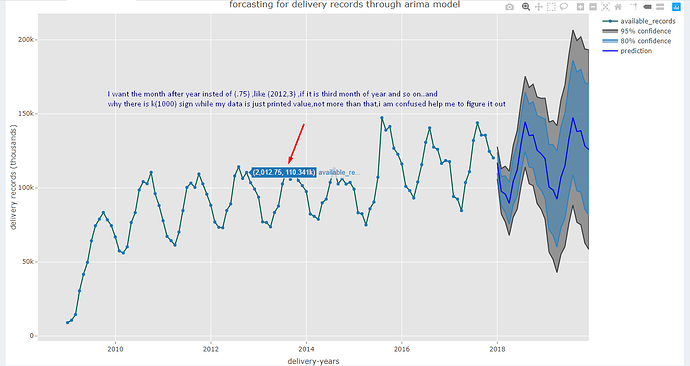timeseies<-ts(dt$Record,start = c(2009,1),frequency = 12)
timeseies
arimodel<-auto.arima(timeseies)
arimodel
predictionf<-forecast(arimodel,h=24,level=c(80,95))
p <- plot_ly() %>%
add_trace(x = ~time(timeseies), y = ~timeseies, type = 'scatter', mode = 'markers',
line = list(color='rgb(0,100,80)'),
name = 'available_records') %>%
# add_lines(x = time(timeseies), y = timeseies,
# color = I("blue"), name = "observed") %>%
add_ribbons(x = time(predictionf$mean), ymin = predictionf$lower[, 2], ymax = predictionf$upper[, 2],
color = I('rgba(67,67,67,1)'), name = "95% confidence") %>%
add_ribbons(x = time(predictionf$mean), ymin = predictionf$lower[, 1], ymax = predictionf$upper[, 1],
color = I('rgba(49,130,189, 1)'), name = "80% confidence") %>%
add_lines(x = time(predictionf$mean), y = predictionf$mean, color = I("blue"), name = "prediction",hoveron = "points") %>%
layout(title = "forcasting for delivery records through arima model",
paper_bgcolor='rgb(255,255,255)', plot_bgcolor='rgb(229,229,229)',
xaxis = list(title = "delivery-years",
gridcolor = 'rgb(255,255,255)',
showgrid = TRUE,
showline = FALSE,
showticklabels = TRUE,
tickcolor = 'rgb(127,127,127)',
ticks = 'outside',
zeroline = FALSE),
yaxis = list(title = "delivery records (thousands)",
gridcolor = 'rgb(255,255,255)',
showgrid = TRUE,
showline = FALSE,
showticklabels = TRUE,
tickcolor = 'rgb(127,127,127)',
ticks = 'outside',
zeroline = FALSE))
p
})
how to make this model better in this scenario...

